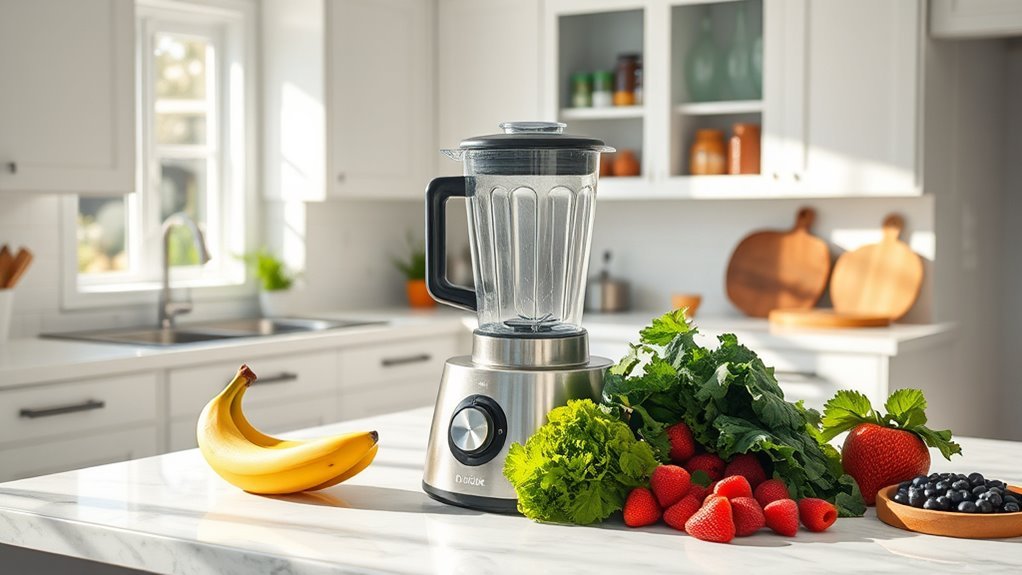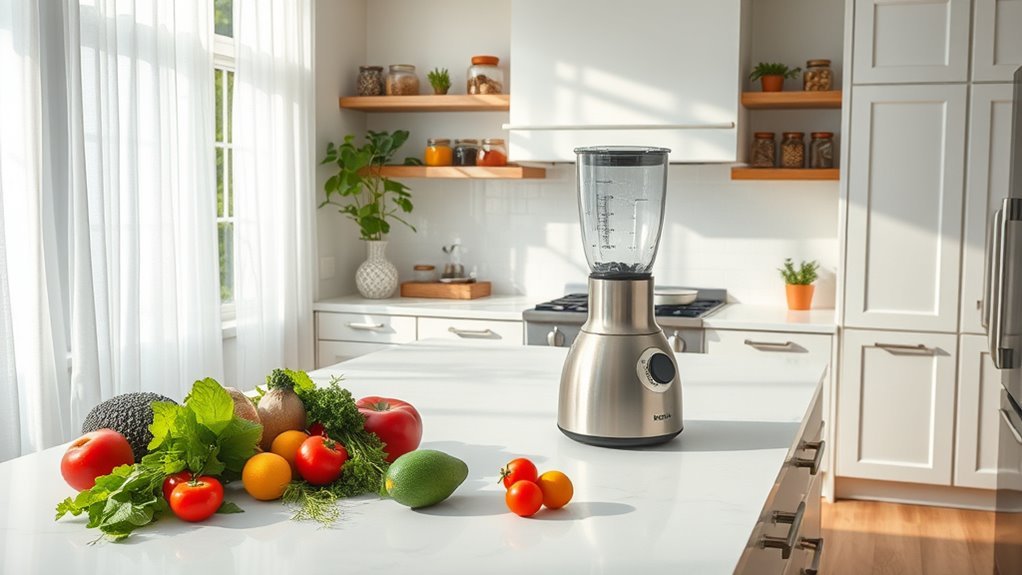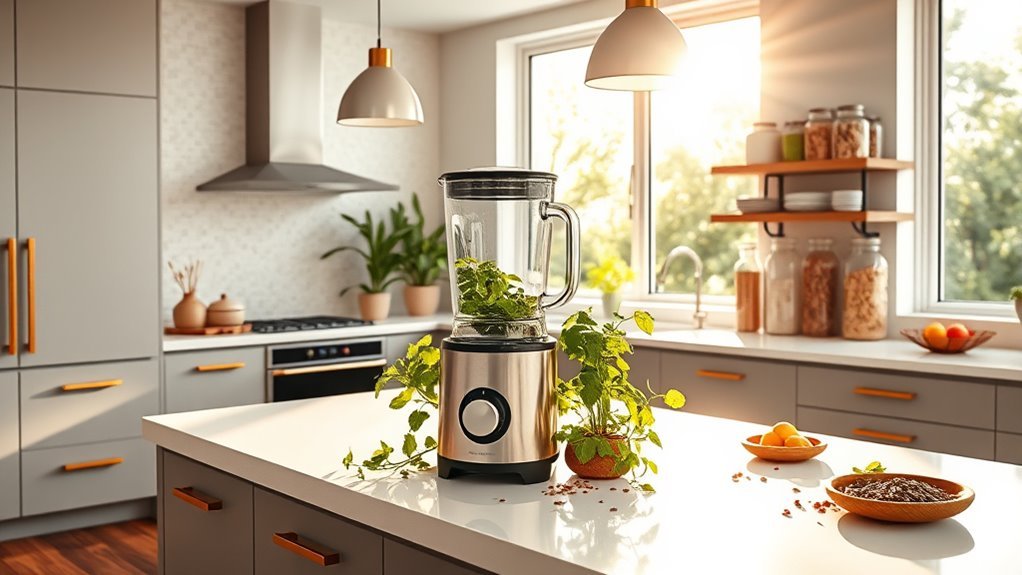We’ll transform your kitchen into an eco-warrior’s paradise with these no-nonsense green cleaning solutions. Start by tackling your blender with a warm water and dish soap blend, followed by a baking soda scrub for stubborn residue. Vinegar-water solutions work magic on dishwashers and appliances, while reusable microfiber cloths slash waste. Monthly coil cleaning cuts energy bills dramatically. These natural methods are just the tip of the sustainability iceberg.
Natural Blender Cleaning Methods That Work

Every blender deserves a proper cleaning, and we’ve got the natural methods that’ll transform your gunky appliance into a sparkling clean machine.
Let’s kickstart your eco-friendly cleaning routine with a foolproof technique: Fill halfway with warm water, add a drop of dish soap, and blend for 30 seconds. Stubborn residue? No problem. Our baking soda solution tackles the tough stuff – just blend and let it sit.
Here’s your power move: Follow up with a white vinegar rinse. It’s nature’s disinfectant and odor killer. Additionally, using these natural methods can help maintain the durability of your blender, ensuring it lasts longer and performs efficiently.
Remember, maintain that motor by never soaking the base – a damp cloth with mild soap does the trick. The secret to a long-lasting blender? Clean it right after use.
These environmentally friendly cleaning methods keep your blender pristine and your conscience clear.
Quick DIY Solutions for Stubborn Residue
Stubborn residue doesn’t stand a chance against our arsenal of DIY cleaning solutions.
We’re tackling kitchen appliances with natural ingredients that deliver powerful results without harsh chemicals.
- Mix baking soda with water into a paste – perfect for attacking stubborn spots on appliances. Apply directly, scrub gently, and watch the grime disappear.
- Transform your stainless steel surfaces with our 2:1 ratio of olive oil and white vinegar. It’s an eco-friendly solution that cleans and shines simultaneously.
- Combat refrigerator odors by placing an open box of baking soda inside. It’s nature’s deodorizer at work.
- For dishwashers, run a hot cycle with white vinegar in the top rack, followed by baking soda sprinkled below. This dynamic duo eliminates both stains and smells.
High-performance blenders are designed to handle tough ingredients, making them ideal for creating nut butters and smoothies from scratch.
Power-Saving Cleaning Techniques

While many cleaning methods focus solely on sparkle, we’re diving into techniques that deliver both spotless results and significant energy savings.
Let’s tackle energy-efficient appliances with smart cleaning strategies. First, we’re ditching harsh cleaning products often found in stores. Instead, we’re embracing eco-friendly cleaning with vinegar and water solutions – perfect for descaling dishwashers and breaking down grime.
To reduce energy consumption, we’ll clean those refrigerator coils monthly – it’s a game-changer for healthier living and lower bills. The environmentally safe steam cleaning method works wonders on ovens, and it’s chemical-free.
Finally, we’re sealing gaps around appliances to prevent energy loss. These techniques don’t just reduce waste; they transform your kitchen into a model of sustainable efficiency.
Zero-Waste Maintenance Practices
Traditional maintenance often creates mountains of waste, but we’re about to change that game completely.
Let’s revolutionize our cleaning routine with zero-waste practices that keep our kitchen appliances sparkling while staying green.
- Ditch store-bought cleaners for natural alternatives – mix equal parts vinegar and water for a powerful, biodegradable solution that cuts through grime.
- Switch to reusable cleaning tools – swap paper towels for washable microfiber cloths and sustainable scrubbers.
- Create an eco-friendly maintenance schedule using natural products like baking soda for tough stains and mineral buildup.
- Turn cleaning waste into gold by composting organic debris from refrigerator cleanouts and collecting food scraps during the process.
When repairs are needed, we’ll choose sustainable service providers who prioritize reduce waste practices and eco-friendly products.
Sustainable Blender Care Essentials

Keeping your blender eco-friendly isn’t just about what you blend – it’s about how you maintain it.
We’ll show you how to maximize your blender’s longevity while minimizing environmental impact.
Let’s start with sustainable cleaning tools: ditch those harsh chemicals for a simple mix of warm water and eco-friendly dish soap.
Got stubborn food residues? Baking soda’s cleaning power works wonders.
Quick rinse after each use? That’s how we reduce water waste, folks.
Want to level up your eco game? Consider blenders made from recycled materials to reduce plastic waste.
And here’s a pro tip: regularly clean and store your blender in a dry spot – it’s the secret to keeping mold at bay.
When it comes to eco-friendly alternatives, these small changes make a massive difference in your kitchen’s environmental footprint.
Frequently Asked Questions
Are Eco Cleaning Products Worth It?
We’ve found eco cleaning products are worth it, offering health benefits and environmental impact reduction. They’re increasingly cost-effective and efficient, with transparent ingredients that align with our growing preference for sustainable solutions.
Can I Use Simple Green to Clean My Kitchen?
Like a fresh spring breeze, we can confidently use Simple Green in our kitchens as a non-toxic, multi-purpose cleaner that safely tackles grease and grime while keeping our environment and families protected.
What Are Green Appliances?
We’ve found green appliances are energy-efficient devices made with eco-friendly materials, designed to save water and reduce environmental impact. They include sustainable kitchen tools carrying green certifications from eco-conscious brands.
Which of the Following Are Greener Alternatives to Traditional Cleaning Products?
Like Mother Nature’s own recipe book, we’ll find our answer in natural cleaners, homemade solutions with vinegar, baking soda, essential oils, citrus cleaners, biodegradable products, eco-friendly brands, and plant-based ingredients.

